10 charts looking back at the crypto market in 2024

Reprinted from panewslab
12/27/2024·4MSource: Kaiko Research
Compiled by: Deng Tong, Golden Finance
1. BTC’s road to the $100,000 mark
2024 is going to be a successful year for Bitcoin. With the launch of spot BTC exchange-traded funds in January, the market has gradually matured and the fourth halving has gone smoothly.
Not even a few multi-billion dollar liquidations and sell-offs could stop BTC’s success this year. The price of BTC in USD terms is up nearly 140% so far this year, an even greater increase relative to other fiat currencies (some of which have experienced significant depreciation in 2019).
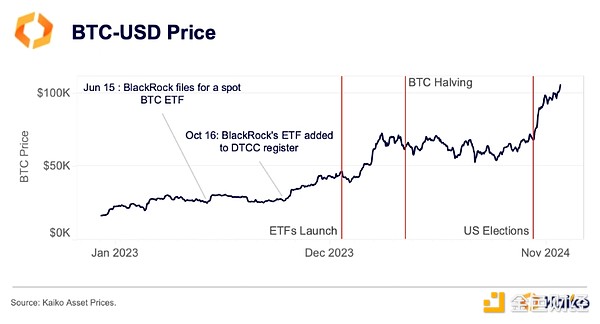
2. The U.S. election spurs bullish bets
The 2024 U.S. election has huge implications for cryptocurrencies. Bitcoin or digital assets have never received so much attention on the world stage — at least not so actively.
President Trump expressed support over the summer for progressive regulation and open dialogue with industry. He even appeared at the Bitcoin Nashville conference shortly after an attempt was made on his life. Much of the cryptocurrency community has rallied around Republican and eventual Democratic candidate Kamala Harris, starting to make some positive moves around cryptocurrencies.
Ahead of the November 5 election, Bitcoin saw a “Trump trade” among market participants. A special election contract on Deribit attracted billions in volume and open interest ahead of the election, with traders betting on all-time highs seeing a significant bullish bias shortly after the election. They were right, and by November BTC trading volume exceeded $75,000.
The overall Senate vote, as well as the final outcome, was widely seen as favorable for cryptocurrencies. As a result, BTC led the post-election rally in crypto assets, topping $80,000 by November 11.
As we showed above, increasingly bullish sentiment continued through the remainder of November into December, with Bitcoin’s current all-time high exceeding $107,000.
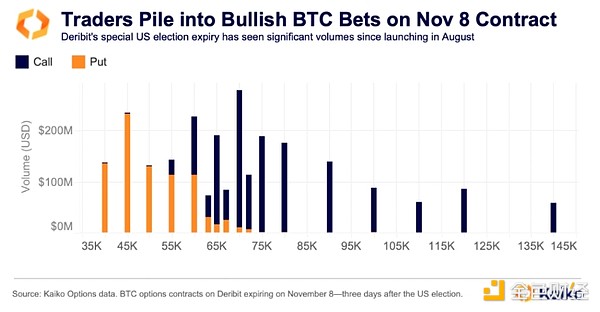
3. Bitcoin fees soar ahead of fourth halving
Bitcoin’s fourth halving occurred on April 19 this year. On Saturday, Bitcoin’s average transaction fees surged, reaching an all-time high of $146. This is significantly higher than Ethereum’s average fee of $3 for the day.
Bitcoin’s historic spike in network fees is perhaps the most important development of its fourth quarter. Despite the warning signs, it came as a surprise to many market participants.
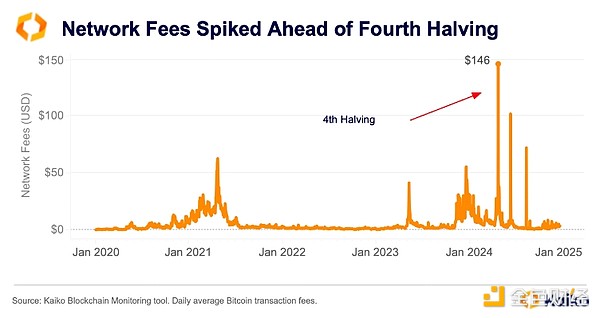
Ordinals founder Casey Rodamor has announced plans to launch Runes, a protocol that will make it easier to issue fungible tokens on Bitcoin. However, users may have anticipated the increase in transaction fees based on Ordinals’ impact on transaction fees, but the historic increase still surprised many.
Ordinals allow node operators to burn data and images onto newly created Bitcoin blocks. These so-called “registries,” similar to NFTs, increase demand for Bitcoin block space and increase the fees BTC miners earn.
The release of Runes happened in a similar fashion. The launch of the protocol resulted in increased demand for block space, which in turn impacted fees.
4. BlackRock surpasses Grayscale
BTC ETFs have broken all kinds of records this year, with total assets under management rising to over $100 billion across 11 funds.
BlackRock was the big winner, signaling major institutional interest in Bitcoin and digital assets. Its spot BTC ETF has over $55 billion in assets under management, surpassing Grayscale’s GBTC within months. Launched in 2013 by digital asset management firm Grayscale, GBTC is very much a cryptocurrency-first product, and its large premium/discount to NAV means limited institutional buying. So when the ETF launched this year, it was quickly overtaken by BlackRock.
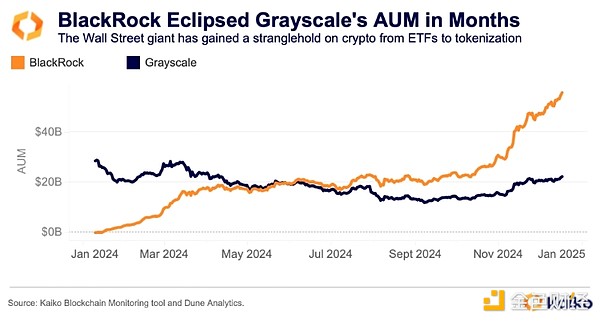
GBTC has been hemorrhaging assets for much of the year after the company decided to keep fees at 1.5%. In the U.S. ETF space, companies are used to low fees, so much of Wall Street prefers BlackRock and Fidelity to GBTC.
5. ETH/BTC ratio drops
Since the merger, the ETH/BTC ratio has continued to decline and shows no signs of slowing down in 2024. This ratio compares the performance of the two assets and falls when Ethereum underperforms Bitcoin.
Other factors contributing to the decline include the rise of Solana as users migrated to cheaper networks during heightened speculation in March and the fourth quarter of this year. Meme tokens (which we will discuss in a moment) are behind much of the speculation and have driven Solana DEX trading volume to overtake Ethereum at times this year.
It fell to 0.033 in November, the lowest level since March 2021. What 's behind the poor performance? Since the merger, ETH has faced significant regulatory pressure as staking has come under scrutiny in the United States, drawing the ire of the SEC.
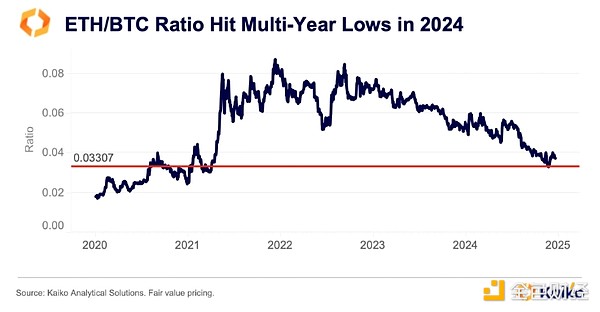
6. Slow start: ETH ETF launched
The ETH ETF has had a slow start since its launch in July. Similar to the launch of the BTC ETF, Grayscale’s fund has once again put pressure on the market as the digital asset manager maintains fees at 2%.
However, the newly launched fund started seeing inflows in late 2024 after outflows from Grayscale's ETHE decreased. Since the U.S. election in November, capital inflows have increased significantly, and traders have flocked to CME’s ETH futures. This reflects similar activity seen on BTC futures in May and June when traders executed arbitrage trades.
Rising ETH futures open interest and a change in the regulatory outlook reversed course for the ETH ETF, with net flows turning positive in late November and December. Net traffic since launch now exceeds $2 billion. This included more than $3 billion in outflows from ETHE.
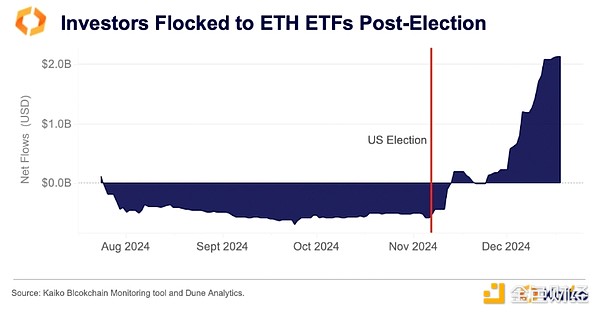
ETH will be one of the biggest winners from regime change in Washington, DC. While it has lagged behind Bitcoin this year, the second-largest asset by market capitalization will benefit greatly from regulatory shifts brought about by the change in U.S. government. ETH classification, commodity or security, and clarity on staking are likely to be the two main drivers of growth next year.
7. Trend-setting MicroStrategy bought more BTC than ever before
MicroStrategy has had its busiest year yet when it comes to buying BTC. The business software company has in many ways pivoted from its core business this year. Chairman and former CEO Michael Saylor even called his company the world’s first “Bitcoin finance company” during its third-quarter results report in November.
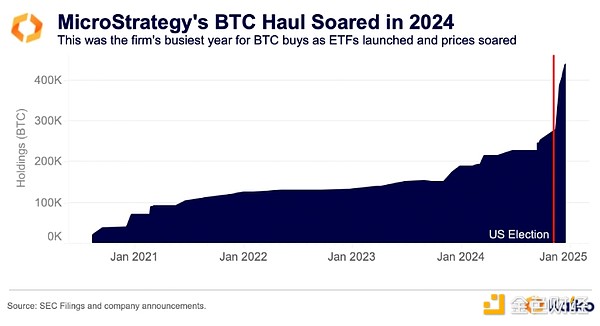
MicroStrategy has purchased more than 249,850 Bitcoins since January, with purchases accelerating since the U.S. election and holdings nearly doubling in the past month. The company has issued multiple convertible bonds to fund its acquisitions, prompting concerns among some market participants that a price collapse could adversely affect the company and could even lead to a forced sell-off.
For now, this strategy is working. The rapid rise in BTC prices and bullish sentiment in the market caused the value of MSTR to surge to an all-time high. MSTR hit a new high for the first time in 24 years since the dot-com bubble burst in March 2000.
While MicroStrategy is a pioneer in corporate purchases of Bitcoin, some Republican lawmakers want the U.S. government to follow suit. Senator Cynthia Loomis has pledged to establish a strategic Bitcoin reserve after Donald Trump wins the US presidential election.
8. The Alameda gap has narrowed after the ETF was listed.
This year, the crypto market finally put the FTX crash behind it. The liquidity gap left by the collapse of FTX and its sister company Alameda Research, or Alameda Gap, has closed this year.
Driven by rising prices and growing market share, Bitcoin's market depth of 1% this year has exceeded FTX's previous level of approximately $120 million. Kraken, Coinbase and LMAX Digital have seen the most notable recoveries. Notably, institutional-focused LMAX’s Bitcoin market depth reached a record $27 million this week, briefly surpassing Bitstamp to become the third-largest liquid Bitcoin market.
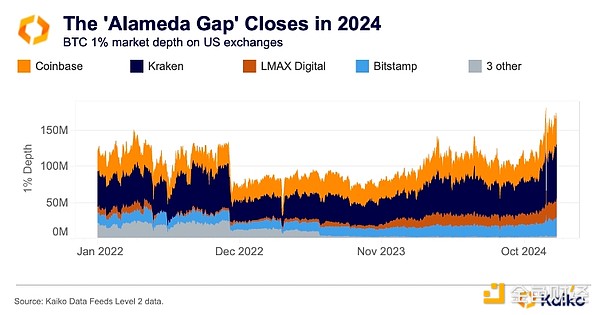
9. Meme Token Mania
As mentioned above, meme tokens have surged exponentially at different times this year. In particular, tokens on Solana have experienced significant growth due to the launch of Pump dot fun, a protocol for launching meme tokens that allows anyone to issue tokens and build them from the ground up through word of mouth and participation Liquidity.
However, familiar assets largely dominate trading volumes on centralized exchanges. Similar to previous gains in 2021, Dogecoin is once again favored by traders - again due to post-election bullish sentiment. Dogecoin moved higher after President-elect Donald Trump revealed plans to establish the Department of Government Effectiveness (DOGE), headed by Elon Musk and Vivek Ramaswamy.
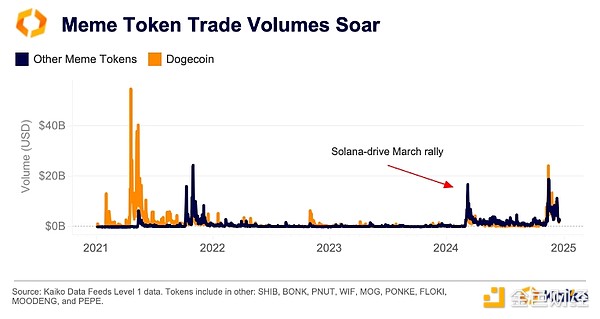
One of the new tokens launched on Solana this year is PNUT, which has captured the imagination and was inspired by Peanut the Squirrel, a New York pet influencer whose untimely death led to an outpouring of support online ( and token issuance).
One trader even turned a $16 investment in PNUT into $3 million in realized profits. PNUT is currently traded on several large centralized exchanges, including Binance, Crypto.com and OKX.
10. Regulation triggers changes in the stablecoin market
Regulation in Europe has been reshaping the stablecoin market since June. The landmark European Market Regulation of Crypto-Assets (MiCA) has triggered a wave of stablecoin delistings and adjustments to product offerings from major exchanges.
Throughout 2024, EUR/Cryptocurrency trading volumes have remained above last year’s average, indicating growing demand. Three months after MiCA was enacted, the euro-backed stablecoin market has undergone a major shift, driven by the rise of MiCA-compliant alternatives. By November 2024, MiCA-compliant euro stablecoins (including Circle’s EURC, Société Générale’s EURCV and Banking Circle’s EURI) had accounted for a record 91% market share.
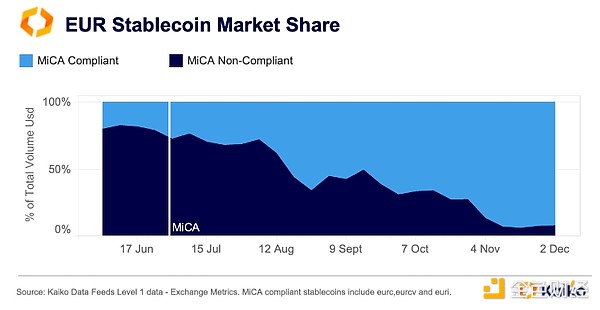
After listing EURI at the end of August, Binance has become a major player in the euro stablecoin market, on par with Coinbase. Still, Coinbase remains the largest market with a 47% share, driven by Circle’s EURC.
in conclusion
This year has been important for establishing digital assets as viable assets for Wall Street investors. Time will tell whether the industry can continue to grow in the coming months and years, but this rebound feels different.
The 2024 rally is built on the arrival of established companies with risk frameworks (which currently includes BTC and ETH). The rally over the next year is expected to extend beyond Bitcoin and extend to other assets as regulations shift and market structure changes.



 jinse
jinse